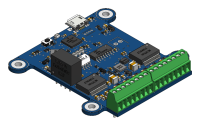 The Yocto-Maxi-IO-V2 device provides 8 digital I/O, electrically isolated from the USB bus. Each I/O bit can be configured individually as a simple input, an open-drain input (internal pull-up), a TTL/CMOS-like output, or an open-drain output (open collector).
The Yocto-Maxi-IO-V2 device provides 8 digital I/O, electrically isolated from the USB bus. Each I/O bit can be configured individually as a simple input, an open-drain input (internal pull-up), a TTL/CMOS-like output, or an open-drain output (open collector).
Without external power source, each I/O pin can receive or produce a digital signal at 3V or 5V levels (low current).
With an external power source, the device can work with voltages up to 28V and deliver up to 250mA per channel, which makes it possible to drive small relays for instance.
If you need 4 channels only, you can use the Yocto-IO instead.
USB cables and enclosures to be ordered separately.
